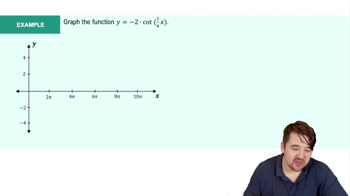Table of contents
- 0. Functions7h 52m
- Introduction to Functions16m
- Piecewise Functions10m
- Properties of Functions9m
- Common Functions1h 8m
- Transformations5m
- Combining Functions27m
- Exponent rules32m
- Exponential Functions28m
- Logarithmic Functions24m
- Properties of Logarithms34m
- Exponential & Logarithmic Equations35m
- Introduction to Trigonometric Functions38m
- Graphs of Trigonometric Functions44m
- Trigonometric Identities47m
- Inverse Trigonometric Functions48m
- 1. Limits and Continuity2h 2m
- 2. Intro to Derivatives1h 33m
- 3. Techniques of Differentiation3h 18m
- 4. Applications of Derivatives2h 38m
- 5. Graphical Applications of Derivatives6h 2m
- 6. Derivatives of Inverse, Exponential, & Logarithmic Functions2h 37m
- 7. Antiderivatives & Indefinite Integrals1h 26m
1. Limits and Continuity
Finding Limits Algebraically
Problem 2.4.9c
Textbook Question
The graph of ℎ in the figure has vertical asymptotes at x=−2 and x=3. Analyze the following limits. <IMAGE>
lim x→−2 h(x)
 Verified step by step guidance
Verified step by step guidance1
Step 1: Identify the type of limit problem. Since the problem involves a vertical asymptote at x = -2, we are dealing with a limit where the function approaches infinity or negative infinity.
Step 2: Understand the behavior of the function near the asymptote. As x approaches -2, the function h(x) will either increase or decrease without bound.
Step 3: Consider the direction of approach. Determine if you need to evaluate the limit from the left (x approaches -2 from the left, denoted as x → -2⁻) or from the right (x approaches -2 from the right, denoted as x → -2⁺).
Step 4: Analyze the graph of h(x) near x = -2. Observe whether the function values are increasing towards positive infinity or decreasing towards negative infinity as x approaches -2 from either side.
Step 5: Conclude the limit based on the behavior observed. If the function approaches positive infinity from both sides, the limit is positive infinity. If it approaches negative infinity, the limit is negative infinity. If the behavior differs from each side, the limit does not exist.
Recommended similar problem, with video answer:
 Verified Solution
Verified SolutionThis video solution was recommended by our tutors as helpful for the problem above
Video duration:
2mPlay a video:
Was this helpful?
Key Concepts
Here are the essential concepts you must grasp in order to answer the question correctly.
Vertical Asymptotes
Vertical asymptotes occur in the graph of a function where the function approaches infinity or negative infinity as the input approaches a certain value. In this case, the function h(x) has vertical asymptotes at x = -2 and x = 3, indicating that as x approaches these values, h(x) will either increase or decrease without bound.
Recommended video:

Introduction to Cotangent Graph Example 1
Limits
A limit describes the behavior of a function as the input approaches a particular value. In the context of the question, evaluating the limit of h(x) as x approaches -2 involves determining what value h(x) approaches as x gets closer to -2, which is critical for understanding the function's behavior near its vertical asymptote.
Recommended video:

One-Sided Limits
One-Sided Limits
One-sided limits refer to the limits of a function as the input approaches a specific value from one side only, either the left or the right. For the limit lim x→−2 h(x), it is important to consider both the left-hand limit (as x approaches -2 from values less than -2) and the right-hand limit (as x approaches -2 from values greater than -2) to fully understand the behavior of h(x) near the asymptote.
Recommended video:

One-Sided Limits

 5:21m
5:21mWatch next
Master Finding Limits by Direct Substitution with a bite sized video explanation from Callie
Start learningRelated Videos
Related Practice







